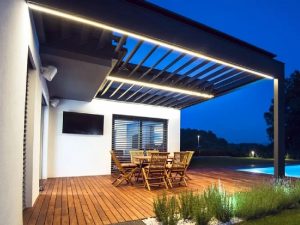Outdoor living has become a big part of North American life. Whether it’s hosting a barbecue, relaxing with family, or extending your dining space outdoors, a well-designed patio cover can transform your backyard into a year-round retreat.

But what exactly is a patio cover, and which type is right for your home or project? With insights from LIDA OUTDOOR, a professional patio shade product manufacturer, you’ll learn what a patio cover is, the different patio cover styles, materials, and design options, so you can make an informed choice that fits both your space and your budget.
Before we begin, it’s worth noting that in this guide we’re referring to the narrow definition of a patio cover — a fixed roof structure that provides shade and weather protection for a patio or deck. In a broader sense, the term patio cover can also include other outdoor shade structures such as gazebos, awnings, and pergolas, all of which serve a similar purpose: creating a comfortable, usable outdoor space.
What Is a Patio Cover? Definition & Origins
The idea of covered outdoor spaces isn’t new — it dates back to ancient Roman courtyards and Mediterranean patios designed for rest and social gatherings. The word “patio” comes from Spanish and refers to an open courtyard in traditional homes where families would relax and dine together.
Over time, as architecture evolved across Europe and North America, people began adding protective structures over their patios to block sun and rain. That simple idea eventually became what we now call a patio cover.
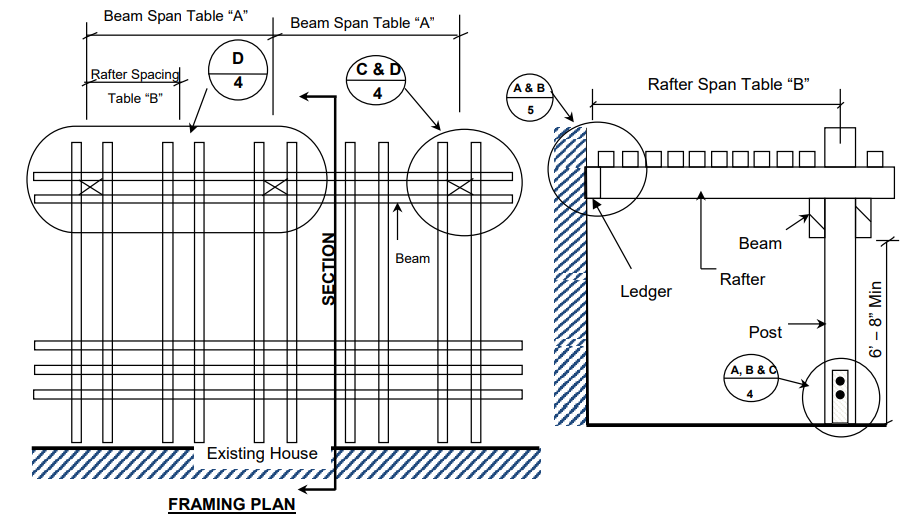
A patio cover is a fixed shade structure installed above a patio, deck, or outdoor seating area. It can be attached to the exterior wall of a house or built as a free-standing unit in the yard. Its primary purpose is to provide shade, weather protection, and year-round comfort, turning outdoor areas into functional extensions of your home.
For both residential and commercial properties, patio covers offer more than just comfort — they enhance the aesthetic appeal, property value, and usability of outdoor spaces.
Patio Cover vs. Pergola vs. Awning vs. Gazebo
However, patio covers are often confused with other popular outdoor structures, such as pergolas, awnings, and gazebos. To help you distinguish them, here’s a simple comparison:
| Structure | Description | Function | Mobility | Typical Materials |
| Patio Cover | Fixed roof structure, attached or freestanding | Full shade and rain protection | Permanent | Aluminum, steel, wood, polycarbonate |
| Pergola | Open roof with lattice beams | Partial shade, decorative | Fixed | Wood, aluminum, steel |
| Awning | Flexible canopy mounted on walls | Adjustable shade and rain protection | Retractable | Fabric, aluminum |
| Gazebo | Standalone enclosed structure with a roof | All-around shade, shelter, and aesthetics | Semi-permanent | Steel, aluminum, fabric, polycarbonate |
Types of Patio Covers (Structure & Roof Designs)
After understanding how a patio cover differs from other outdoor structures, let’s take a closer look at its main design categories and material options. The type of structure and roof design you choose will determine not only how your patio looks, but also how it performs in different weather conditions and how much maintenance it requires.
1. Structural Types
Patio covers come in several structural designs, each with its own benefits, limitations, and ideal use cases. Now let’s have a look.
(1) Attached Patio Cover
An attached patio cover is the most common type. One side is connected to the exterior wall of the house, while the other side is supported by columns or posts. This design integrates the cover with the home’s architecture, creating a seamless indoor–outdoor transition and providing strong weather resistance.
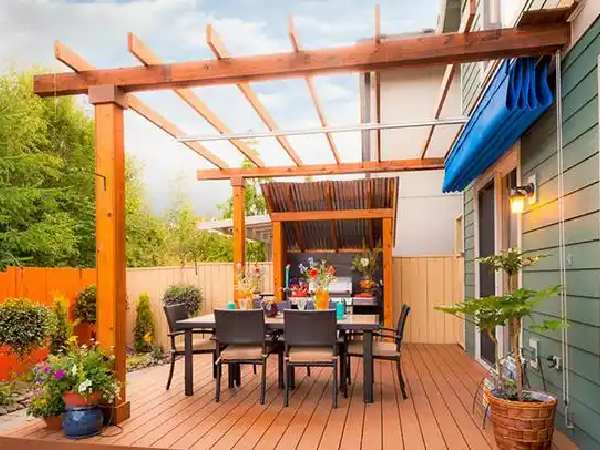
Because it relies on the building’s structure for support, attached patio covers offer excellent wind stability and waterproofing, making them ideal for decks or patios connected to living rooms or kitchens.
However, installation often requires building permits and structural evaluations, especially in regions like California or Texas. Local building departments may have specific rules on size, wind load, and materials — checking these requirements before installation can save you time, cost, and compliance issues.
(2) Freestanding Patio Cover
A freestanding patio cover is completely independent of the main building and is typically supported by four or more columns. This design offers maximum flexibility so that you can install it in the middle of a garden, beside a pool, or in an outdoor dining area.
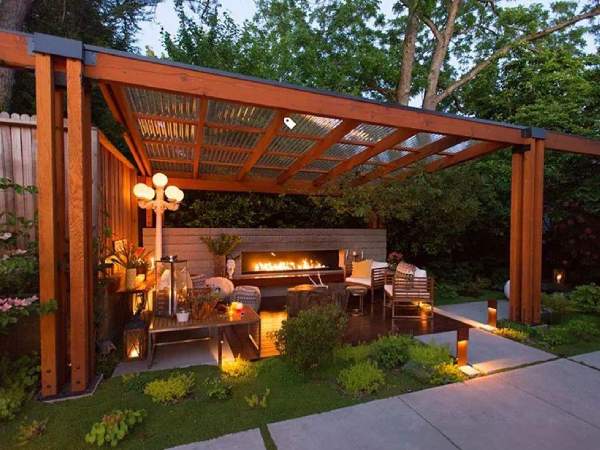
Freestanding covers are perfect for larger residential properties or commercial settings such as restaurants or resorts. Since they don’t rely on a wall for support, they require stronger foundations and wind bracing to ensure stability in harsh weather.
(3) Retractable Patio Cover
A retractable patio cover is a modern, adaptable option that allows users to control sunlight and shade with ease. Its roof system can slide or fold open and closed, either manually or with an electric motor. On sunny days, you can fully open it for natural light; when it rains, simply close it for complete protection.
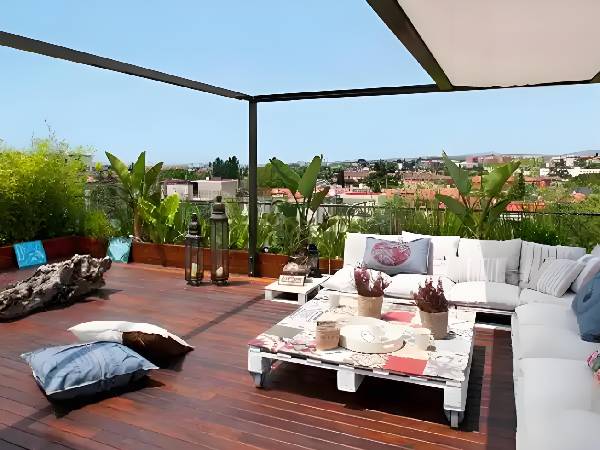
Retractable covers are especially popular for cafés, hotel patios, and luxury homes, as they combine high functionality with visual appeal. However, they come with higher installation and maintenance costs, so it’s essential to choose a reliable motor system and waterproof materials.
2. Roof Designs
Besides the structure, the roof design also plays a crucial role in both the appearance and performance of your patio cover. Here are the three most common roof types that you will see on a popular patio cover.
(1) Solid Roof
A solid roof provides complete protection from sunlight, rain, and debris. Typically made from aluminum, steel, or polycarbonate panels, this roof design allows you to enjoy your patio year-round, regardless of the weather.
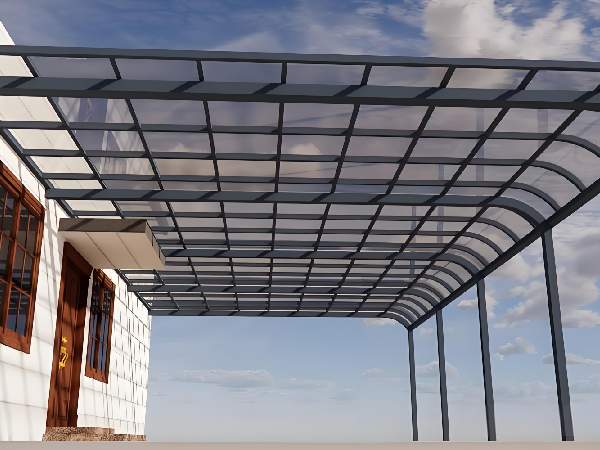
In this way, solid roofs are excellent for areas with heavy rainfall or intense sunlight. If you prefer more natural light, consider adding skylights or integrated LED lighting to maintain brightness and comfort.
(2) Lattice Roof
A lattice roof features an open-beam design that filters sunlight while maintaining airflow. This creates a soft, dappled light effect and perfect for gardens or regions with mild, sunny climates. For additional shade, you can drape shade cloths or climbing plants over the structure to combine beauty and practicality.
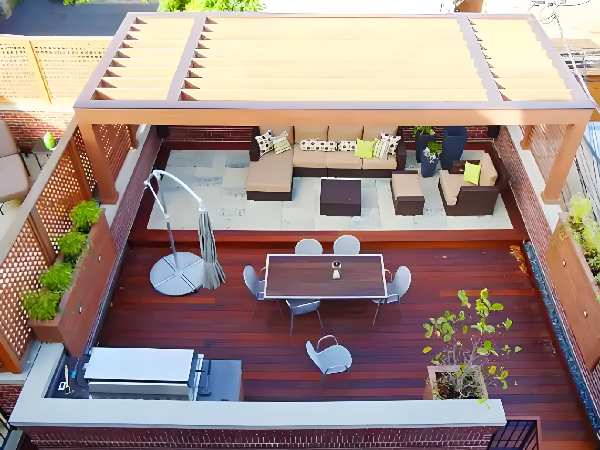
(3) Insulated Roof
An insulated roof is designed for maximum comfort, temperature control, and energy efficiency. It’s typically built with multi-layered panels, containing a foam or polyurethane core sandwiched between two aluminum or steel sheets. With fully or partially enclosed sides, this design effectively reduces heat transfer and noise, making the patio cover usable year-round, even in cold winter months.
Insulated roofs are ideal for restaurants, commercial patios, and year-round residential spaces. While more expensive upfront, they deliver long-term savings through better energy performance and durability.
Patio Cover Materials Explained
Beyond structural design and roof style, the choice of material is equally important. The material determines the strength, durability, maintenance frequency, and even the overall look of your patio cover. As a result, patio covers can also be categorized by material type — each offering unique performance and aesthetics.
| Material | Key Features | Maintenance | Ideal For |
| Wood | Natural look and customizable | Requires regular sealing or painting to prevent cracking or insects | Luxury homes and natural-style designs |
| Aluminum | Lightweight, corrosion-resistant, modern appearance | Virtually maintenance-free | Both residential and commercial projects |
| Steel | Strongest option, handles wind and snow loads well | Requires anti-rust coating | Large commercial spaces or high-wind regions |
| Vinyl (PVC) | Affordable, lightweight, available in many colors | Prone to fading or aging over time | Small patios or budget-conscious projects |
| Polycarbonate | High light transmission, UV protection, weatherproof | Easy to clean, long-lasting | Spaces needing natural light, such as poolside or greenhouses |
Tip: For commercial projects or long-term residential use, aluminum and galvanized steel are the most reliable materials. They deliver excellent structural strength, weather resistance, and a clean, modern aesthetic — all with minimal upkeep.
Pros and Cons of Patio Covers
After exploring the structure, roof types, and materials of patio covers, it’s time to look at their overall performance. Like any architectural addition, patio covers come with both advantages and limitations. So in this part, let’s explore the main pros and cons of this structure design.
| Aspect | Pros | Cons |
| Functionality | Provides excellent shade and rain protection, significantly enhancing the usability of outdoor spaces. | Fixed structure with limited flexibility — not easily moved or adjusted once installed. |
| Aesthetics | Seamlessly integrates with the home’s architecture, improving visual appeal and property value. | Higher upfront cost, especially for metal or insulated models. |
| Comfort | Maintains a pleasant outdoor temperature across various weather conditions, making it suitable for year-round use. | Enclosed or solid designs may reduce natural light and airflow. |
| Durability | Long lifespan, particularly for aluminum and steel structures. | Some materials, such as wood, require regular maintenance to prevent cracking or decay. |
| Construction & Compliance | Offers strong stability and is built for long-term use. | In many regions (e.g., California), permits and professional installation are required, which may extend the project timeline. |
Tip: If you’re managing a commercial project or a bulk installation, factor in the permit approval and construction timelines early in your planning. Doing so can prevent unexpected delays, keep your budget on track, and ensure compliance with local building codes.
Patio Cover Cost in the U.S. (2025 Update)
In the U.S., the cost of installing a patio cover typically ranges from US $50 to $150 per square foot, including materials and labor.
That means a standard 10′ × 20′ structure (about 200 ft²) may cost US $10,000 – 30,000, depending on the design complexity, materials, and local labor rates. Basic DIY aluminum or vinyl kits from retailers like The Home Depot may start at US $1,000–5,000, but they don’t include professional installation or permits.
Get A Free Patio Cover Calculator >
The following table summarizes the average price range by material and roof type:
| Material / Roof Type | Typical Cost (US$/ft²) | Description |
| Aluminum / Vinyl | 20 – 60 | Most affordable options; lightweight, low-maintenance, and easy to install. |
| Wood / Steel | 60 – 120 | Mid- to high-end choices; strong and durable with a natural or modern look. |
| Insulated Roof Systems | 100 – 150 | Premium designs; often include enclosed sides or thermal panels for year-round comfort. |
Tip: Before installation, check your local building requirements, as permits and engineering approvals can significantly affect the total cost — especially in states like California or Texas. Always request an itemized quote listing structure, roofing, foundation, and permit fees to avoid hidden expenses and ensure transparent budgeting.
Smart Alternatives to Traditional Patio Covers
As we showed in the previous section, while patio covers offer great functionality and visual appeal, they also come with a few downsides — higher costs, complex permit requirements, and longer installation timelines. For many contractors, retailers, and project planners seeking faster, more flexible outdoor solutions, choosing alternative structures can be a smarter, more cost-effective option.

At LIDA OUTDOOR, we offer a range of outdoor shade products that balance aesthetics, performance, and practicality. These include gazebos, pergolas, and retractable awnings — each offering strong protection from sun and rain while remaining easy to install and customize.
Unlike traditional patio covers, these structures require no complicated permits or permanent foundations, allowing you to quickly create functional outdoor areas with minimal disruption. They also support OEM/ODM customization and bulk production, giving distributors and commercial clients greater flexibility in both design and delivery.
Conclusion
A patio cover is both functional and beautiful. With the proper structure, roof design, and materials, it can transform a simple patio into a stylish, weather-protected area you can enjoy year-round.
However, a patio cover isn’t always the best choice for every project. Its higher upfront cost, permit requirements, and longer installation process can be challenging for those prioritizing flexibility or tight timelines. That’s why exploring alternative shade structures, such as gazebos, pergolas, and retractable awnings, can be a smart, efficient option — especially for businesses and project developers seeking faster delivery and cost control.


